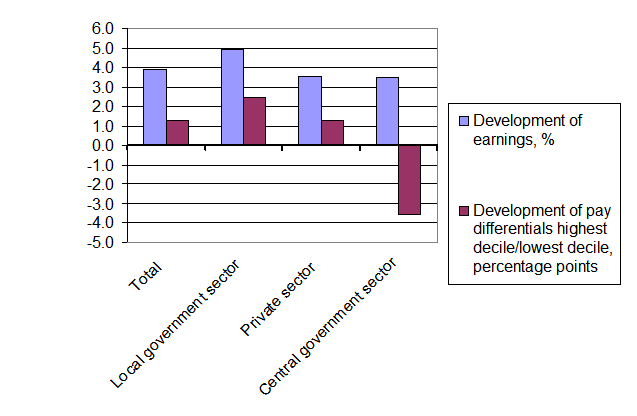Published: 27 April 2007
Narrowing of gender wage gap has slowed down in recent years
An examination of the total earnings of full-time wage and salary earners indicates that the wage gap between the genders has remained nearly unchanged in the 2000s. The average monthly earnings of all full-time wage and salary earners totalled EUR 2,555 in the last quarter of 2005. Men earned EUR 2,813 and women EUR 2,275. In 2005, women earned 80.9 per cent, and in 2001, 80.2 per cent of men's earnings. There was no change in the gender wage gap between 2004 and 2005. Placement of women and men in different tasks is one reason for the earnings differential between the genders.
In 2005, ten per cent of all full-time wage and salary earners earned more than EUR 3,741 and, respectively, ten per cent of them earned less than EUR 1,656. The difference in earnings between the highest and the lowest decile increased by 1.3 percentage points from 2004. The difference in total earnings between the deciles went up most, or by 2.5 percentage points, in the local government sector. In the private employer sector the pay differential grew by 1.3 percentage points, whereas in the central government sector the pay differentials between wage and salary earners narrowed by 3.6 percentage points from the year before. Most of the development in earnings between the sectors is explained by different sizes of collectively bargained pay increases and by changes in the structure of wage and salary earners, such as exits to retirement, outsourcing of tasks or increased employment among full-time wage and salary earners in certain wage and salary earner groups.
The data derive from Statistics Finland's Structure of Earnings statistics which cover all employer sectors. Monthly earnings for total hours worked are only calculated for full-time wage and salary earners. Apart from earnings for regular working hours, total earnings also include pay for any possible overtime and working hour supplements, but not yearly paid bonuses.
Change in monthly earnings and pay differentials in different employer sectors 2004-2005

Source: Structure of Earnings 2005. Statistics Finland
Inquiries: Mr Antti Katainen +358 9 1734 2347, Ms Kaisa Salli +358 9 1734 2580, palkkarakenne.tilastokeskus@stat.fi
Director in charge: Mr Kari Molnar
- Tables
-
Tables in databases
Pick the data you need into tables, view the data as graphs, or download the data for your use.
Last updated 27.4.2007
Official Statistics of Finland (OSF):
Structure of Earnings [e-publication].
ISSN=1799-0092. 2005. Helsinki: Statistics Finland [referred: 23.12.2025].
Access method: http://stat.fi/til/pra/2005/pra_2005_2007-04-27_tie_001_en.html

